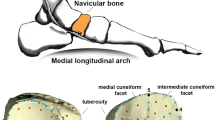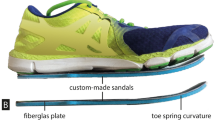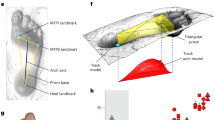Abstract
The stiff human foot enables an efficient push-off when walking or running, and was critical for the evolution of bipedalism1,2,3,4,5,6. The uniquely arched morphology of the human midfoot is thought to stiffen it5,6,7,8,9, whereas other primates have flat feet that bend severely in the midfoot7,10,11. However, the relationship between midfoot geometry and stiffness remains debated in foot biomechanics12,13, podiatry14,15 and palaeontology4,5,6. These debates centre on the medial longitudinal arch5,6 and have not considered whether stiffness is affected by the second, transverse tarsal arch of the human foot16. Here we show that the transverse tarsal arch, acting through the inter-metatarsal tissues, is responsible for more than 40% of the longitudinal stiffness of the foot. The underlying principle resembles a floppy currency note that stiffens considerably when it curls transversally. We derive a dimensionless curvature parameter that governs the stiffness contribution of the transverse tarsal arch, demonstrate its predictive power using mechanical models of the foot and find its skeletal correlate in hominin feet. In the foot, the material properties of the inter-metatarsal tissues and the mobility of the metatarsals may additionally influence the longitudinal stiffness of the foot and thus the curvature–stiffness relationship of the transverse tarsal arch. By analysing fossils, we track the evolution of the curvature parameter among extinct hominins and show that a human-like transverse arch was a key step in the evolution of human bipedalism that predates the genus Homo by at least 1.5 million years. This renewed understanding of the foot may improve the clinical treatment of flatfoot disorders, the design of robotic feet and the study of foot function in locomotion.
This is a preview of subscription content, access via your institution
Access options
Access Nature and 54 other Nature Portfolio journals
Get Nature+, our best-value online-access subscription
$29.99 / 30 days
cancel any time
Subscribe to this journal
Receive 51 print issues and online access
$199.00 per year
only $3.90 per issue
Buy this article
- Purchase on Springer Link
- Instant access to full article PDF
Prices may be subject to local taxes which are calculated during checkout




Similar content being viewed by others
Data availability
The data supporting the findings of this study are available within the paper and its Supplementary Information.
References
Susman, R. L. Evolution of the human foot: evidence from Plio-Pleistocene hominids. Foot Ankle 3, 365–376 (1983).
Bramble, D. M. & Lieberman, D. E. Endurance running and the evolution of Homo. Nature 432, 345–352 (2004).
Takahashi, K. Z., Gross, M. T., van Werkhoven, H., Piazza, S. J. & Sawicki, G. S. Adding stiffness to the foot modulates soleus force-velocity behaviour during human walking. Sci. Rep. 6, 29870 (2016).
Pontzer, H. Economy and endurance in human evolution. Curr. Biol. 27, R613–R621 (2017).
Holowka, N. B. & Lieberman, D. E. Rethinking the evolution of the human foot: insights from experimental research. J. Exp. Biol. 221, jeb174425 (2018).
DeSilva, J., McNutt, E., Benoit, J. & Zipfel, B. One small step: a review of Plio-Pleistocene hominin foot evolution. Am. J. Phys. Anthropol. 168, 63–140 (2019).
Morton, D. J. Evolution of the longitudinal arch of the human foot. J. Bone Joint Surg. 6, 56–90 (1924).
Hicks, J. H. The mechanics of the foot: II. The plantar aponeurosis and the arch. J. Anat. 88, 25–30 (1954).
Ker, R. F., Bennett, M. B., Bibby, S. R., Kester, R. C. & Alexander, R. M. The spring in the arch of the human foot. Nature 325, 147–149 (1987).
D’Août, K., Aerts, P., De Clercq, D., De Meester, K. & Van Elsacker, L. Segment and joint angles of hind limb during bipedal and quadrupedal walking of the bonobo (Pan paniscus). Am. J. Phys. Anthropol. 119, 37–51 (2002).
Bates, K. T. et al. The evolution of compliance in the human lateral mid-foot. Proc. R. Soc. B 280, 20131818 (2013).
DeSilva, J. M. et al. Midtarsal break variation in modern humans: functional causes, skeletal correlates, and paleontological implications. Am. J. Phys. Anthropol. 156, 543–552 (2015).
Holowka, N. B., O’Neill, M. C., Thompson, N. E. & Demes, B. Chimpanzee and human midfoot motion during bipedal walking and the evolution of the longitudinal arch of the foot. J. Hum. Evol. 104, 23–31 (2017).
MacKenzie, A. J., Rome, K. & Evans, A. M. The efficacy of nonsurgical interventions for pediatric flexible flat foot: a critical review. J. Pediatr. Orthop. 32, 830–834 (2012).
Baxter, J. R. et al. Reconstruction of the medial talonavicular joint in simulated flatfoot deformity. Foot Ankle Int. 36, 424–429 (2015).
Morton, D. J. Evolution of the human foot II. Am. J. Phys. Anthropol. 7, 1–52 (1924).
Hayafune, N., Hayafune, Y. & Jacob, H. Pressure and force distribution characteristics under the normal foot during the push-off phase in gait. Foot 9, 88–92 (1999).
Bennett, M. B., Ker, R. F. & Alexander, R. M. Elastic strain energy storage in the feet of running monkeys. J. Zool. 217, 469–475 (1989).
Farris, D. J., Kelly, L. A., Cresswell, A. G. & Lichtwark, G. A. The functional importance of human foot muscles for bipedal locomotion. Proc. Natl Acad. Sci. USA 116, 1645–1650 (2019).
Heard-Booth, A. N. Morphological and Functional Correlates of Variation in The Human Longitudinal Arch. PhD thesis, Univ. Texas, Austin (2017).
Griffin, N. L., Miller, C. E., Schmitt, D. & D’Août, K. Understanding the evolution of the windlass mechanism of the human foot from comparative anatomy: insights, obstacles, and future directions. Am. J. Phys. Anthropol. 156, 1–10 (2015).
Williams, D. S. & McClay, I. S. Measurements used to characterize the foot and the medial longitudinal arch: reliability and validity. Phys. Ther. 80, 864–871 (2000).
Leakey, M. D. & Hay, R. L. Pliocene footprints in the Laetolil Beds at Laetoli, northern Tanzania. Nature 278, 317–323 (1979).
Crompton, R. H. et al. Human-like external function of the foot, and fully upright gait, confirmed in the 3.66 million year old Laetoli hominin footprints by topographic statistics, experimental footprint-formation and computer simulation. J. R. Soc. Interface 9, 707–719 (2012).
Nguyen, K., Yu, N., Bandi, M. M., Venkadesan, M. & Mandre, S. Curvature-induced stiffening of a fish fin. J. R. Soc. Interface 14, 20170247 (2017).
Harcourt-Smith, W. E. H. et al. The foot of Homo naledi. Nat. Commun. 6, 8432 (2015).
Day, M. H. & Napier, J. R. Fossil foot bones. Nature 201, 969–970 (1964).
Pontzer, H. et al. Locomotor anatomy and biomechanics of the Dmanisi hominins. J. Hum. Evol. 58, 492–504 (2010).
Haile-Selassie, Y. et al. A new hominin foot from Ethiopia shows multiple Pliocene bipedal adaptations. Nature 483, 565–569 (2012).
Ward, C. V., Kimbel, W. H. & Johanson, D. C. Complete fourth metatarsal and arches in the foot of Australopithecus afarensis. Science 331, 750–753 (2011).
Raichlen, D. A., Gordon, A. D., Harcourt-Smith, W. E., Foster, A. D. & Haas, W. R. Jr. Laetoli footprints preserve earliest direct evidence of human-like bipedal biomechanics. PLoS ONE 5, e9769 (2010).
Schultz, A. H. Relations between the lengths of the main parts of the foot skeleton in primates. Folia Primatol. 1, 150–171 (1963).
Gomberg, D. N. Form and Function of The Hominoid Foot. PhD thesis, Univ. Massachusetts, Amherst (1981).
Wang, W. J. & Crompton, R. H. Analysis of the human and ape foot during bipedal standing with implications for the evolution of the foot. J. Biomech. 37, 1831–1836 (2004).
Anapol, F., Turner, T. R., Mott, C. S. & Jolly, C. J. Comparative postcranial body shape and locomotion in Chlorocebus aethiops and Cercopithecus mitis. Am. J. Phys. Anthropol. 127, 231–239 (2005).
Sirianni, J. E., Swindler, D. R. & Tarrant, L. H. Somatometry of newborn Macaca nemestrina. Folia Primatol. 24, 16–23 (1975).
Rodman, P. Skeletal differentiation of Macaca fascicularis and Macaca nemestrina in relation to arboreal and terrestrial quadrupedalism. Am. J. Phys. Anthropol. 51, 51–62 (1979).
Schindelin, J. et al. Fiji: an open-source platform for biological-image analysis. Nat. Methods 9, 676–682 (2012).
Hamada, Y. Standard growth patterns and variations in growth patterns of the japanese monkeys (Macaca fuscata) based on an analysis by the spline function method. Anthropol. Sci. 102, 57–76 (1994).
Hessman, F. V. Figure Calibration: a plug-in for ImageJ. http://www.astro.physik.uni-goettingen.de/~hessman/ImageJ/Figure_Calibration (2009).
Acknowledgements
We thank D. Lieberman for discussions on the manuscript and S. Piazza for constructive contributions. Access to skeletal specimens was provided by G. Aronsen, K. Zyskowski, E. Sargis, Yale Biological Anthropology Laboratories and the Yale Peabody Museum. K. J. Meacham III provided experimental support. S. James helped with figures. Funding support came from the Human Frontier Science Program.
Author information
Authors and Affiliations
Contributions
M.V., M.M.B. and S.M. conceived the study; A.Y. and M.V. designed the foot mimics and A.Y. performed the experiments; C.M.E., A.Y. and M.V. designed, collected and analysed the data from the cadaveric experiments in consultation with S.M.T.; A.Y., C.M.E. and M.V. collected and analysed the morphometric data from cadaveric and living human feet in consultation with A.H.H.; M.A.D. and S.M. performed the mathematical modelling in consultation with M.V.; D.K.S. and M.M.B. performed the shell experiments in consultation with M.V.; M.V. planned and wrote the paper; M.V. planned and prepared the figures and tables; M.V., A.Y., S.M., M.A.D. and M.M.B. wrote the Supplementary Information; and all authors contributed to editing the paper.
Corresponding authors
Ethics declarations
Competing interests
The authors declare no competing interests.
Additional information
Peer review information Nature thanks Stephen Piazza and the other, anonymous, reviewer(s) for their contribution to the peer review of this work.
Publisher’s note Springer Nature remains neutral with regard to jurisdictional claims in published maps and institutional affiliations.
Extended data figures and tables
Extended Data Fig. 1 Illustrated anatomy of the foot.
a, Identification of the bones of the foot that are referred to in the main text. The cuneiforms, cuboid and the navicular are collectively referred to as the tarsal bones. b, The plantar fascia, a tough elastic band, extends from the calcaneus to the distal end of the phalanges. The fascia split and rejoin at multiple locations. c, The long plantar, short plantar and calcaneonavicular ligaments are located in the midfoot and are primarily longitudinally oriented. The deep and superficial transverse metatarsal ligaments are examples of stiff, transversally oriented elastic tissues between the metatarsals. Anatomical images are from Primal Pictures.
Extended Data Fig. 2 Mathematical and computational analysis of continuum elastic shells.
a, The shell is clamped at one end and loaded with a knife edge at the other. It is of length L, width w, thickness t and has radius of curvature R (curvature c = 1/R). b, The free end displaces by a height δz on loading and reaction forces at the clamped end resist deformation. c, A cross-sectional view of the shell shows the location of the neutral plane, if the shell were to act as an elastic beam. d, Out-of-plane (z-axis) displacement profile for one numerical simulation of a shell (L = 0.1 m, w = 0.05 m, t = 0.003 m, R = 0.03 m). Most of the displacement happens close to the loaded edge, unlike an elastic beam. e, The stress component σxx is shown as a colour map of the undeformed shell. In an elastic beam, the intersection of the neutral plane with the shell (c) would exactly match the locations of zero stress. Because of curvature-induced in-plane stretching, the zero-stress curve differs from the neutral plane predictions in the vicinity of the loaded edge and—to a lesser extent—near the clamped boundary.
Extended Data Fig. 3 Experimental characterization of arched shells.
a, The experimental set-up used in stiffness measurements. b, A magnification of the shell from underneath shows how a curvature-matched edge-loading attachment was used to mimic a theoretical knife edge. A curvature-matched clamp was fixed and glued to the other end of the shell. c, Representative data that show the linearity of the force–displacement data. The best-fit quadratic is indistinguishable from the linear fit to within sensor resolution. d, e, The Young’s modulus (d) and Poisson’s ratio (e) of the PDMS material used to fabricate the shells were estimated from simultaneous stress and strain measurements during an extension test of a rectangular PDMS block.
Extended Data Fig. 4 Design and characterization of discrete mechanical foot mimics.
a, Experimental arrangement for load–displacement measurements. The distal loading platforms for the three metatarsals are staggered in height so that all three metatarsals are loaded vertically despite the transverse curvature. In hominin feet, this is accomplished by the metatarsal torsion. b, Side view of a single metatarsal showing length L and thickness t of the foot mimics. The effect of thickness is to provide a moment arm for the longitudinal spring and thus affect the rotational stiffness of the hinge. c, Mimics with three different thicknesses were fabricated and the thickness was estimated using load–displacement measurements on curvature-free flat mimics. The accuracy of the estimated thickness values are evaluated by plotting the predicted stiffness based on the thickness estimates against the measured stiffness. Details of the thickness estimation technique and statistics of the stiffness–stiffness correlation are provided in Supplementary Information 4.4.
Extended Data Fig. 5 Effect of cutting the transverse springs in mechanical foot mimics.
Stiffness of transversally curved foot mimics lacking the transverse inter-metatarsal springs (T−) is strongly correlated with the stiffness of flat mimics with intact transverse inter-metatarsal springs.
Extended Data Fig. 6 Transverse curvature of hominin feet.
a, Definitions of length L and width w. b, Definition of the thickness t. The fourth metatarsal is highlighted in green. The distal heads of the metatarsals rest flat on the ground and the proximal heads are raised away from the ground to different degrees because of the TTA. c, Schematic showing the accrual of torsion on the lateral metatarsals about their long axis. The curvature of the TTA was estimated using the torsion of the fourth metatarsal θMT4. In addition, the average curvature was also estimated using the angle of the normal to the dorsal surface of the fourth metatarsal θdorsal, as measured in the midfoot (Supplementary equation (5.3)). d, Linear regression of the two methods to estimate TTA curvature. Details of the curvature estimation procedure and statistical results of the regression are provided in Supplementary Information 5.1.
Supplementary information
Supplementary Information
Supplementary notes regarding (S1) Foot stiffness, (S2) Mathematical modelling of continuum shells, (S3) Experiments on continuum shells, (S4) Mechanical mimics of the foot, and (S5) Human and other hominin feet.
Source data
for Fig. 4 are comprised of 3D surface reconstructions of the fourth metatarsal from volumetric CT scans of 6 feet from human volunteers, and 6 cadaveric feet. Each filename follows the format <specimen ID>-MT4.stl.
Source data
Rights and permissions
About this article
Cite this article
Venkadesan, M., Yawar, A., Eng, C.M. et al. Stiffness of the human foot and evolution of the transverse arch. Nature 579, 97–100 (2020). https://doi.org/10.1038/s41586-020-2053-y
Received:
Accepted:
Published:
Issue Date:
DOI: https://doi.org/10.1038/s41586-020-2053-y
This article is cited by
-
New Perspectives on Foot Segment Forces and Joint Kinetics—Integrating Plantar Shear Stresses and Pressures with Multi-segment Foot Modeling
Annals of Biomedical Engineering (2024)
-
Custom orthotic design by integrating 3D scanning and subject-specific FE modelling workflow
Medical & Biological Engineering & Computing (2024)
-
Functional significance of vertical free moment for generation of human bipedal walking
Scientific Reports (2023)
-
Arched footprints preserve the motions of fossil hominin feet
Nature Ecology & Evolution (2023)
-
Multi-objective parametric optimization of a composite high-performance prostheses using metaheuristic algorithms
Structural and Multidisciplinary Optimization (2023)
Comments
By submitting a comment you agree to abide by our Terms and Community Guidelines. If you find something abusive or that does not comply with our terms or guidelines please flag it as inappropriate.



